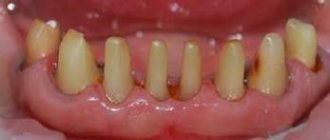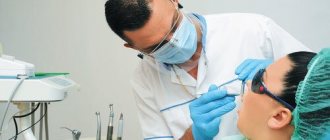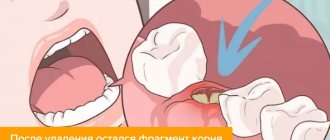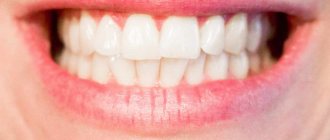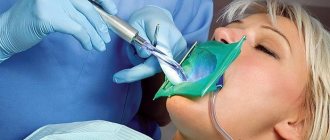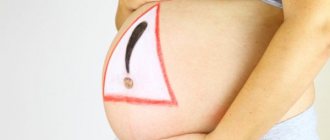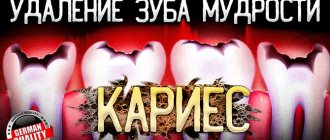Removing the 6th tooth is an operation that is performed quite often. Since sixes have rather deep fissures, their complete cleaning is difficult, which provokes the rapid development of caries. Externally, such damage is difficult to determine. after all, a cavity can form under the enamel. The extraction procedure will allow you to avoid the development of unwanted diseases, and if you follow the dentist’s recommendations, complications during the rehabilitation period.
Indications and contraindications for molar tooth extraction
It is impossible to determine the indications for the removal of molars in absentia; this requires an examination by an experienced dentist. Recommendations for carrying out extraction are:
- purulent periostitis when it is impossible to drain exudate through the root canal, abscess, phlegmon;
- purulent-inflammatory periodontal diseases, cystic formations, the presence of a tumor;
- longitudinal axial fracture of the dental crown, pulp exposure;
- destruction of the crown, excluding its reconstruction;
- incorrect position of the tooth, as a result of which the mucous membrane is injured or it is impossible to install an orthopedic prosthesis;
- diseases in which destructive changes in bone tissue occur;
- advanced inflammation of the paranasal sinuses, sinusitis.
There are the following contraindications for removal:
- exacerbation of cardiovascular diseases (pre-infarction condition, angina pectoris, arrhythmia, hypertension);
- acute respiratory viral diseases (including influenza and sore throat);
- general diseases of the body (renal failure, pancreatitis, infectious hepatitis);
- damage to the nervous system;
- the presence of neoplasms, hemophilia, leukemia, radiation sickness;
- the first and last months of pregnancy;
- inflammatory dental diseases (gingivitis, stomatitis);
- exhaustion of the patient’s body, dystrophy;
- alcohol intoxication.
Only a doctor has the right to make a decision about removal, carefully weighing all the pros and cons.
In what cases is removal of the upper tooth inevitable?
Medical indications for extraction of the upper tooth can be divided into planned and emergency. The planned ones include:
- periodontal inflammation or the formation of a cyst at the roots of a tooth with impenetrable roots;
- tumors of the upper jaw;
- the presence of unerupted, out of place or extra teeth that cause discomfort (damaging soft tissues, causing speech defects, preventing normal chewing of food, increasing the risk of developing inflammatory processes);
- destruction of the crown that cannot be restored;
- periodontal inflammation, one of the signs of which is pathological tooth mobility;
- fractures of tooth roots;
- the presence of teeth that interfere with orthopedic or orthodontic treatment.
Emergency indications are:
- purulent inflammation of the bone tissue of the upper jaw, occurring in an acute form;
- destruction of the crown of a tooth that has no functional value.
In addition, severe toothaches that cannot be eliminated by conservative methods (for example, in case of complex crown fractures) can be the basis for unscheduled extraction.
How the removal process occurs (video)
Before removing a diseased tooth, the doctor must take an x-ray to determine the location of the roots. Removal takes place with an anesthetic injection.
The doctor carefully separates the gum, grabs the tooth with forceps and begins to pull it out, rocking or twisting it, depending on the number of roots. After this, you can pull the tooth out of the alveoli. Removing the lower and upper teeth is not much different; the upper molars are somewhat more difficult to grasp correctly.
«
In more advanced cases, the doctor can divide the dental crown into pieces using a drill and tear them apart. This method helps protect the jaw from damage.
When removing an impacted tooth or root fragments, it is first necessary to cut the mucous membrane, free access to the dental crown, and then begin pulling out. This complex removal is often performed under general anesthesia.
Removal of a molar tooth with a cyst requires a highly qualified dental surgeon and is performed under both local and general anesthesia.
Two days after removal, it is necessary to examine the patient and do a control x-ray to exclude the presence of “forgotten” root fragments in the jaw.
Removal steps
Preparation
The dentist-surgeon examines the patient’s oral cavity and prescribes x-rays, if necessary. X-ray examination reveals the structural features, condition and exact location of the roots, and shows the presence of hidden inflammatory processes. The doctor selects the painkiller and dosage, finds out if the patient has any contraindications or allergies.
Important! If you have any fears, doubts or questions, it is best to discuss them with your doctor before the procedure.
Operation
During one operation, the tooth must be fragmented along the roots, and then removed as carefully and minimally invasively as possible, without destroying the bone tissue surrounding the six. In case of complex tooth extraction (if the six is hidden by the gum), the gum is cut, the tooth is destroyed using special tools and removed in parts.
Is it painful to remove a molar tooth, pain after removal
The pain of extraction is a thing of the past - modern painkillers can make the process completely painless, even when removing a tooth with a nerve. The patient is more likely to be concerned about pain after removal.
It is impossible to unequivocally answer the question of how much the gums hurt after such traumatic manipulations. The pain is quite strong at first, but later it will be less intense.
The doctor will definitely recommend an effective pain reliever for the first time.
You should pay attention to the nature of the pain: if it intensifies, becomes “knocking”, tugging, this is a signal about the beginning of dangerous suppuration of the hole. You need to see a doctor as soon as possible.
Preparing to remove the six
- Correct selection of tools. There are several types of forceps and elevators that can only be used when removing specific teeth. An error in choosing a tool leads to quite unpleasant consequences: for example, the removal of the 6th tooth of the upper or lower jaw cannot be carried out with narrow forceps - this will lead to the fact that it will either be crushed, or the patient will feel pain at the time of direct removal.
- Be sure to choose the right anesthesia before the procedure. Most use local anesthesia - an injection of lidocaine or ultracaine. But in some cases, such drugs are not suitable - for example, if the patient has an individual intolerance. Another point that dentists usually do not take into account is the fear of dentists, which amounts to dental phobia. To calm the patient down, you can sedate the patient and the doctor’s removal procedures will be absolutely calm.
- An examination of the oral cavity before tooth extraction is a mandatory procedure. This rule is due to the fact that after the removal of some teeth, problems with neighboring ones may begin. For example, removing a six implies some impact on the entire row.
Features of molar removal during pregnancy
During pregnancy, it is advisable to avoid any surgical interventions that negatively affect the condition of the expectant mother. Ideally, it is best to treat everything prophylactically before the onset of an interesting condition. If your tooth hurts while waiting for your baby, pay attention to the following points:
- Removal is not recommended in the first and last months, when the baby is most vulnerable.
- There is no need to expose the body to unnecessary stress, if we are talking about a planned operation, it is better to wait until the birth of the child.
- Any intervention should be carried out solely for health reasons.
- You definitely need to warn your doctor about your situation, he will select the most harmless anesthetic that does not penetrate the placental barrier.
If tooth extraction is complicated, it is advisable to do it in a hospital under the supervision of experienced doctors; during the first 2-3 days, the temperature may rise, which is extremely undesirable for expectant mothers.
Molar tooth extraction in children
A child’s molar can be either a baby tooth or a permanent tooth; depending on this, treatment tactics are differentiated. If the permanent one has already begun to grow, and the milk tooth has not yet fallen out, but is already wobbly, the pediatric dentist will definitely advise removing the milk tooth that is interfering with normal eruption. If a baby’s permanent molar tooth hurts, the doctor will give preference to conservative treatment in order to preserve the integrity of the dentition.
Premature extraction of baby teeth is undesirable; it negatively affects the formation of the bite.
Clear indications for extraction in children are:
- the presence of a granuloma or dental root cyst.
- inflammation of the tooth root, mandibular nerve.
- complete destruction of the crown.
Features of removing the 6th tooth from below and from above?
Sixes are among those elements of the dentition that are subject to heavy loads during meals. They are involved in the chewing process and for this reason can be destroyed prematurely.
Compared to other units, the extraction process of these teeth is quite difficult. They are distinguished by thickening of the root system, which can be curved or fused.
To carry out a successful operation, it is necessary to involve a doctor with extensive experience, since the location of the units is based in the most dense areas of the alveolar process. Thick partitions between the roots also complicate the procedure. If you compare a six with an eight, it will become clear that its extraction will require more effort, since the 6th molar is more massive and has three roots on the upper jaw.
Possible consequences and complications
Extraction, like any operation, can cause a negative reaction from the body. If your cheek is swollen, your throat hurts, or there is a sharp throbbing pain in the socket, there is a high probability of an inflammatory process.
Early complications:
- fainting, shock, collapse;
- fracture, dislocation of the jaw;
- perforation of the maxillary sinus (when removing an upper molar or premolar), falling of root fragments into the gum;
- trauma, dislocation, fracture of an adjacent or opposite tooth;
- severe bleeding, hematoma formation.
Late complications:
- inflammation of the alveoli (alveolitis);
- inflammation of peripheral nerves (neuritis);
- restriction of jaw movement (muscle contracture).
By contacting a specialist in a timely manner, the consequences of removal can be minimized.
Oral care after lower tooth extraction
Upon completion of the dental intervention, the doctor gives the patient recommendations on how to behave so that the recovery is successful and in the shortest possible time. Necessary:
- Do not eat anything for the first two to three hours after treatment. It is important that a clot forms in the hole, which will protect it from the penetration of bacteria.
- Do not touch the wound with your tongue or foreign objects.
- Do not use paste or brush on the day of the procedure.
- Rinse your mouth only if prescribed by your doctor.
- Visit the doctor on the appointed day for a follow-up examination.
It is important to understand that dental operations today are only vaguely reminiscent of those performed a couple of decades ago. They are as gentle as possible and are not associated with pain and long-term rehabilitation.
Is it possible to remove it at home?
Removing a tooth on your own is dangerous; at home, it is difficult to ensure sterility, numb the gums, ensure that the root is completely pulled out, and prevent blood loss and other complications. You can remove only a very loose tooth yourself without risk to your health.
Typically, children's loose baby teeth are removed at home. It is important to remove food debris and thoroughly disinfect the oral cavity. You need to tightly grasp the tooth with your fingers wrapped in sterile gauze, loosen it well and only then pull it. If after the second attempt you are unable to pull out the tooth, entrust this difficult manipulation to an experienced dentist without risking your health.
If the tooth comes out of the socket easily, you need to press the gauze swab firmly onto the wound to stop the bleeding and hold it for 30-40 minutes. You should refrain from eating for two hours.
If any unpleasant discomfort occurs, it is advisable to consult a dentist as soon as possible to prevent complications from developing.
Finally, I would like to remind you: simple preventive measures will allow you to keep your smile snow-white and your teeth healthy and strong for many years.
How long does it take to remove a front tooth?
The time it takes to remove the upper teeth can vary from a few minutes to an hour. On average, the operation takes 15-20 minutes. Much here depends on the initial situation and the qualifications of the dentist.
Removing front teeth is usually simple. Some difficulties may arise when extracting the upper canine, since it has a long, massive root with an often curved apex.
During surgery to remove a front tooth, the patient sits in a chair with a slightly reclined back and headrest. The doctor is in front of the patient on the right. The procedure looks like this:
- the gum is separated from the edge of the alveolus, and the circular ligament is separated from the neck;
- the forceps are applied to the tooth, moved under the gum and fixed;
- the dentist rocks or rotates the tooth to break the fibers connecting the root to the walls of the socket;
- the front tooth is removed from the socket;
- The surgical site is inspected and broken root fragments are removed from the socket.

